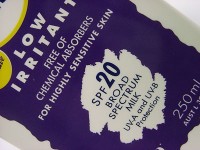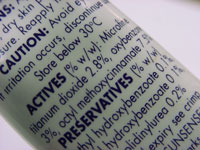Sun Protection Factors (SPF)
All sun-blocks will state their SPFs on the outside. Apart from the traditional sun-blocks, a lot of skin care products nowadays also add in some sun blocking ingradients to emaphsize their anti-photo-aging and whitening effect.
The SPFs can range from 10 to 100 or higher. The higher the figure, the longer it confers protection. It is a measure of after how much loger the skin will get a pre-determined “Minimum Redness” when the skin is exposed to a pre-determined strength of UVB, when compared to a control with no sun-block. A SPF of 15 means that the skin can stay 15 times longer under the sun before it will get the same damages.

Most sunscreens with a SPF of 15 or higher do an excellent job of protecting against UVB. Another way to look at it is in terms of percentages: SPF 15 blocks approximately 93 percent of all incoming UVB rays. SPF 30 blocks 97 percent; and SPF 50 blocks 99 percent. They may seem like negligible differences, but for someone who is sun-sensitive, or has a history of skin cancer, those extra percentages will make a difference.
However, no sunscreens, regardless of strength, should be expected to stay effective longer than two hours without re-application. Also, SPFs only reflect the protect against UVB, they do not have a direct relation to protection from UVA. Some sun-blocks do emphasise this factor by putting up a PFA (protection Factor for UVA) value, such as PA+++, the more + it has, the higher the protection.
Who Should Use Sunscreens?
Children under the age of six months should not be exposed to the sun. Anyone over the age of six months should use a sunscreen daily. Shade and protective clothings are the best ways to protect infants from the sun. Even those who work inside are exposed to ultraviolet radiation for brief periods throughout the day. Also, UVA is not blocked by glass windows.
What's in Sunscreens ?
There are 2 broad categories, most sunscreens use a mixture of both:

These are organic chemicals that can absorb certain ultraviolet wavelengths in the sunlight. They are in general water soluble, easy to use, and easy to conceal after application. The bad thing is very often they cause skin allergy or irritation. The higher the SPF, the more chemicals it contains, and the higher the chance of this problem.
| Common Ingredients | Filter |
|
Butyl Methoxy Dibenzoyl Methane (Avobenzone) |
UVA |
PABA has as much as 70% chance of causing allergic reaction, and is banned in some countries. Octyl Dimethy PABA can even release carcinogenic substances after irradiated by ultra-violet light. The Benzone group also frequently causes skin allergy as well as photo-sensitivity.
Reflective ElementsThey are minerals in composition, forming a layer on the skin to reflect out the ultra-violet lights. They do not cause skin allergy, but they make the preparations thick and sticky, so that it is obvious to have a white layer on the skin and not too comfortable after the application. Because of this, they are prone to block the pores and cause pimples.
| Common Ingredients | Reflect |
|
Titanium Dioxide |
UVA、UVB |
Attention When Buying and Using a Sunscreen
- A broad-spectrum sunscreen offering protection against both UVA and UVB should be used, with an SPF of 15 or higher.
- Apply plenty in order to get the SPF stated.
- Apply 30 minutes before sun exposure to allow the ingredients to fully bind to the skin.
- Apply again the same amount every two hours or immediately after swimming, toweling off, or sweating a great deal.
- Up to 40 percent of the sun's ultraviolet radiation reaches the earth on a completely cloudy day. So apply sunscreen even when on such a day out.
- Look at the ingredients if you have a history of skin allergy. Stop using it as soon as you notice the onset of irritation and write down the active ingredients, so that you can avoid it when buying again next time.
- If put direct under the sun for a long time, the effectiveness of sunscreens may be affected.

